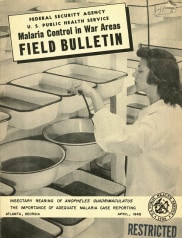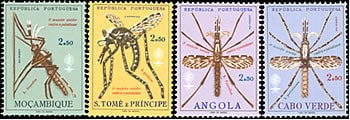Feb 8, 2010. Malaria or a disease resembling malaria has been noted for more than
4,000 years. From the Italian for "bad air," mal'aria has probably
influenced to a great extent human populations and human history.
Ancient History (2700 BCE-340 CE)
The symptoms of malaria were described in ancient Chinese medical
writings. In 2700 BC, several characteristic symptoms of what would
later be named malaria were described in the Nei Ching, The Canon of Medicine). Nei Ching
was edited by Emperor Huang Ti. Malaria became widely recognized in
Greece by the 4th century BCE, and it was responsible for the decline
of many of the city-state populations. Hippocrates noted the principal
symptoms. By the age of Pericles, there were extensive references to
malaria in the literature and depopulation of rural areas was recorded.
In the Susruta, a Sanskrit medical treatise, the symptoms of
malarial fever were described and attributed to the bites of certain
insects. A number of Roman writers attributed malarial diseases to the
swamps.
In China, during the second century BCE, the Qinghao plant (Artemisia annua) was described in the medical treatise, 52 Remedies,
found in the Mawangdui Tomb. In the United States, this plant is known
as the annual or sweet wormwood. In 340 CE, the antifever properties
of Qinghao were first described by Ge Hong of the East Yin Dynasty. The
active ingredient of Qinghao, known as artemisinin, was isolated by
Chinese scientists in 1971. Derivatives of this extract, known
collectively as artemisinins, are today very potent and effective
antimalarial drugs, especially in combination with other medicines.
Back To Top

Plate from "Quinologie", Paris, 1854, showing bark of Quinquina calisaya (from Bolivia).
Quinine (Early 17th Century)
Following their arrival in the New World, Spanish Jesuit missionaries
learned from indigenous Indian tribes of a medicinal bark used for the
treatment of fevers. With this bark, the Countess of Chinchón, the
wife of the Viceroy of Peru, was cured of her fever. The bark from the
tree was then called Peruvian bark and the tree was named
Cinchona after the countess. The medicine from the bark is now known as
the antimalarial, quinine. Along with artemisinins, quinine is one of
the most effective antimalarial drugs available today.
Back To Top

Alphonse Laveran was the first to notice parasites in the blood of a patient suffering from malaria.
Discovery of the Malaria Parasite (1880)
Charles Louis Alphonse Laveran, a French army surgeon stationed in
Constantine, Algeria, was the first to notice parasites in the blood
of a patient suffering from malaria. This occurred on the 6th of
November 1880. For his discovery, Laveran was awarded the Nobel Prize
in 1907.
More on: Laveran and the Discovery of the Malaria Parasite
Differentiation of Species of Malaria (1886)
Camillo Golgi, an Italian neurophysiologist, established that there
were at least two forms of the disease, one with tertian periodicity
(fever every other day) and one with quartan periodicity (fever every
third day). He also observed that the forms produced differing numbers
of merozoites (new parasites) upon maturity and that fever coincided
with the rupture and release of merozoites into the blood stream. He
was awarded a Nobel Prize in Medicine for his discoveries in
neurophysiology in 1906.
Naming of Human Malaria Parasites (1890, 1897)
The Italian investigators Giovanni Batista Grassi and Raimondo Filetti first introduced the names Plasmodium vivax and P. malariae for two of the malaria parasites that affect humans in 1890. Laveran had believed that there was only one species, Oscillaria malariae. An American, William H. Welch, reviewed the subject and, in 1897, he named the malignant tertian malaria parasite P. falciparum.
There were many arguments against the use of this name; however, the
use was so extensive in the literature that a change back to the name
given by Laveran was no longer thought possible. In 1922, John William
Watson Stephens described the fourth human malaria parasite, P. ovale. P. knowlesi
was first described by Robert Knowles and Biraj Mohan Das Gupta in
1931 in a long-tailed macaque. The first documented human infection
with P. knowlesi was in 1965.
Back To Top

Ronald Ross was the first to demonstrate that a mosquito could transmit a (bird) malaria parasite.
Discovery That Mosquitoes Transmit Malaria Parasites (1897-1898)
On August 20th, 1897, Ronald Ross, a British officer in the Indian
Medical Service, was the first to demonstrate that malaria parasites
could be transmitted from infected patients to mosquitoes. In further
work with bird malaria, Ross showed that mosquitoes could transmit
malaria parasites from bird to bird. This necessitated a sporogonic
cycle (the time interval during which the parasite developed in the
mosquito). Thus, the problem of malaria transmission was solved. For
his discovery, Ross was awarded the Nobel Prize in 1902.
More on: Ross and the Discovery that Mosquitoes Transmit Malaria Parasites
Back To Top
Discovery of the Transmission of the Human Malaria Parasites Plasmodium (1898-1899)
Led by Giovanni Batista Grassi, a team of Italian investigators,
which included Amico Bignami and Giuseppe Bastianelli, collected Anopheles claviger mosquitoes and fed them on malarial patients. The complete sporogonic cycle of Plasmodium falciparum, P. vivax, and P. malariae
was demonstrated. In 1899, mosquitoes infected by feeding on a patient
in Rome were sent to London where they fed on two volunteers, both of
whom developed malaria.
Back To Top
The Panama Canal (1905-1910)
The construction of the Panama Canal was made possible only after
yellow fever and malaria were controlled in the area. These two
diseases were a major cause of death and disease among workers in the
area. In 1906, there were over 26,000 employees working on the Canal.
Of these, over 21,000 were hospitalized for malaria at some time during
their work. By 1912, there were over 50,000 employees, and the number
of hospitalized workers had decreased to approximately 5,600. Through
the leadership and efforts of William Crawford Gorgas, Joseph Augustin
LePrince, and Samuel Taylor Darling, yellow fever was eliminated and
malaria incidence markedly reduced through an integrated program of
insect and malaria control.
More on: The Panama Canal
Back To Top
The U.S. Public Health Service (USPHS) and Malaria (1914-1942)
During the U.S. military occupation of Cuba and the construction of
the Panama Canal at the turn of the 20th century, U.S. officials made
great strides in the control of malaria and yellow fever. In 1914 Henry
Rose Carter and Rudolph H. von Ezdorf of the USPHS requested and
received funds from the U.S. Congress to control malaria in the United
States. Various activities to investigate and combat malaria in the
United States followed from this initial request and reduced the
number of malaria cases in the United States. USPHS established
malaria control activities around military bases in the malarious
regions of the southern United States to allow soldiers to train year
round.
Back To Top
The U.S. Tennessee Valley Authority (TVA) - The Integration of Malaria Control with Economic Development (1933)
U.S. President Franklin D. Roosevelt signed a bill that created the
TVA on May 18, 1933. The law gave the federal government a centralized
body to control the Tennessee River's potential for hydroelectric power
and improve the land and waterways for development of the region. An
organized and effective malaria control program stemmed from this new
authority in the Tennessee River valley. Malaria affected 30 percent
of the population in the region when the TVA was incorporated in 1933.
The Public Health Service played a vital role in the research and
control operations and by 1947, the disease was essentially eliminated.
Mosquito breeding sites were reduced by controlling water levels and
insecticide applications.
Back To Top
Chloroquine (Resochin) (1934, 1946)
Chloroquine was discovered by a German, Hans Andersag, in 1934 at
Bayer I.G. Farbenindustrie A.G. laboratories in Eberfeld, Germany. He
named his compound resochin. Through a series of lapses and confusion
brought about during the war, chloroquine was finally recognized and
established as an effective and safe antimalarial in 1946 by British and
U.S. scientists.
Back To Top
Dichloro-diphenyl-trichloroethane (DDT) (1939)
A German chemistry student, Othmer Zeidler, synthesized DDT in 1874,
for his thesis. The insecticidal property of DDT was not discovered
until 1939 by Paul Müller in Switzerland. Various militaries in WWII
utilized the new insecticide initially for control of louse-borne
typhus. DDT was used for malaria control at the end of WWII after it
had proven effective against malaria-carrying mosquitoes by British,
Italian, and American scientists. Müller won the Nobel Prize for
Medicine in 1948.
Back To Top

Cover of a MCWA booklet (1945).
Malaria Control in War Areas (MCWA) (1942-1945)
MCWA was established to control malaria around military training
bases in the southern United States and its territories, where malaria
was still problematic. Many of the bases were established in areas
where mosquitoes were abundant. MCWA aimed to prevent reintroduction of
malaria into the civilian population by mosquitoes that would have fed
on malaria-infected soldiers, in training or returning from endemic
areas. During these activities, MCWA also trained state and local
health department officials in malaria control techniques and
strategies.
CDC and Malaria (1946-present)
CDC's mission to combat malaria began at its inception on July 1,
1946. The Communicable Disease Center, as CDC was first known,
stemmed from MCWA. Thus, much of the early work done by CDC was
concentrated on the control and elimination of malaria in the United
States. With the successful reduction of malaria in the United States,
the CDC switched its malaria focus from elimination efforts to
prevention, surveillance, and technical support both domestically and
internationally. This is still the focus of CDC's malaria work today.
More on: CDC's Origins and Malaria
Back To Top
Elimination of Malaria in the United States (1947-1951)
The National Malaria Eradication Program, a cooperative undertaking
by state and local health agencies of 13 Southeastern states and the
CDC, originally proposed by Louis Laval Williams, commenced operations
on July 1, 1947. By the end of 1949, over 4,650,000 housespray
applications had been made. In 1947, 15,000 malaria cases were reported.
By 1950, only 2,000 cases were reported. By 1951, malaria was
considered eliminated from the United States.
More on: Elimination of Malaria in the United States
Back To Top
Eradication Efforts Worldwide: Success and Failure (1955-1978)

Stamps highlighting malaria eradication
With the success of DDT, the advent of less toxic, more effective
synthetic antimalarials, and the enthusiastic and urgent belief that
time and money were of the essence, the World Health Organization (WHO)
submitted at the World Health Assembly in 1955 an ambitious proposal
for the eradication of malaria worldwide. Eradication efforts began and
focused on house spraying with residual insecticides, antimalarial
drug treatment, and surveillance, and would be carried out in 4
successive steps: preparation, attack, consolidation, and maintenance.
Successes included elimination in nations with temperate climates and
seasonal malaria transmission. Some countries such as India and Sri
Lanka had sharp reductions in the number of cases, followed by
increases to substantial levels after efforts ceased. Other nations had
negligible progress (such as Indonesia, Afghanistan, Haiti, and
Nicaragua). Some nations were excluded completely from the eradication
campaign (most of sub-Saharan Africa). The emergence of drug
resistance, widespread resistance to available insecticides, wars and
massive population movements, difficulties in obtaining sustained
funding from donor countries, and lack of community participation made
the long-term maintenance of the effort untenable. Completion of the
eradication campaign was eventually abandoned.The goal of most current
National Malaria Prevention and Control Programs and most malaria
activities conducted in endemic countries is to reduce the number
of malaria-related cases and deaths. To reduce malaria transmission to
a level where it is no longer a public health problem is the goal of
what is called malaria "control."
Recent increases in resources, political will, and commitment have
led again to discussion of the possibility of malaria elimination and,
ultimately, eradication.
Back To Top